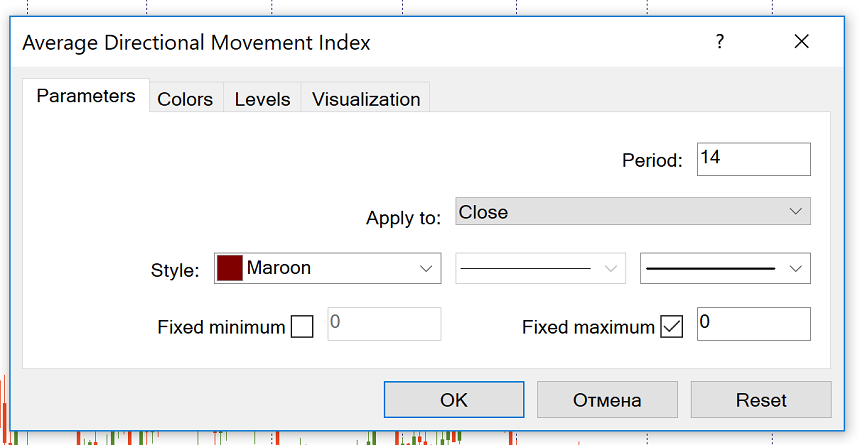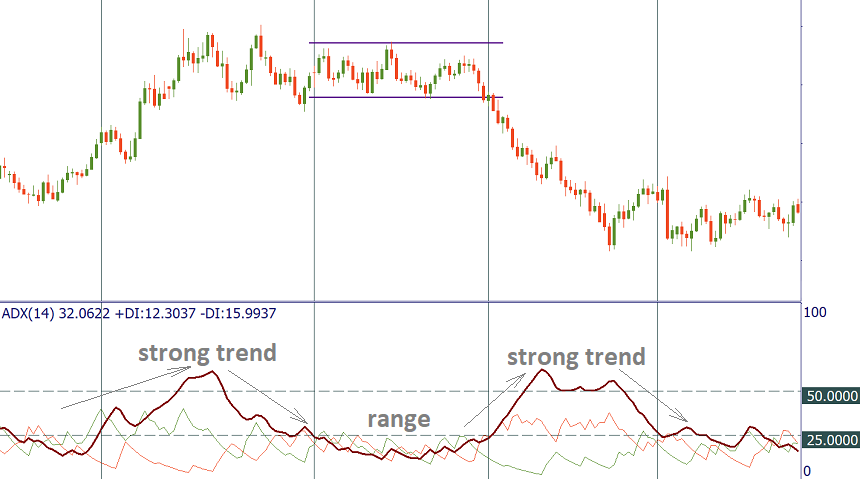ADX - Average Directional Index
Informationen sind keine Investitionsberatung
Der Average Directional Index, kurz ADX, ist der Trendstärke-Indikator. Trendhändler wollen einen starken Trend finden und Positionen in seine Richtung öffnen. Der ADX hilft zu bewerten, wie stark ein Trend ist.
Der Indikator basiert auf einem gleitenden Mittelwert der Expansion der Preisspanne über einen bestimmten Zeitraum.
Wie man implementiert
Sie können den ADX zu einem Chart hinzufügen, dafür klicken Sie auf "Einfügen" - "Indikatoren" - "Trend" und dann auf "Average Directional Movement Index".

Standardmäßig ist die Anzahl der Perioden auf '14' eingestellt. Sie können diese Nummer ändern, wenn Sie möchten.
Wie man benutzt ADX Indikator
Der MT4-Indikator beinhaltet automatisch 3 Linien:
- Average Directional Index (ADX) selbst (dicke braune Linie). Seine Werte reichen von 0 bis 100. Diese Linie registriert die Stärke eines Trends, zeigt aber nicht seine Richtung an.
- Plus Directional Movement Indicator (+DMI) (grüne Linie) ist die Differenz zwischen zwei aufeinanderfolgenden Höchstständen.
- Minus Directional Movement Indicator (-DMI) (rote Linie) ist die Differenz zwischen zwei aufeinanderfolgenden Tiefstständen.
Die ADX-Linie wird verwendet, um festzustellen, ob ein Vermögenswert einen Trend zeigt oder nicht. Ein starker Trend ist vorhanden, wenn ADX über 25 liegt, so dass es sinnvoll ist, Trendhandelsstrategien zu verwenden. Wenn der ADX unter 25 liegt, ist es daher besser, Trendhandel zu vermeiden und eine geeignete Range-Trading-Strategie zu wählen. In solchen Momenten tritt der Kurs in eine Spanne ein. Man muss darauf achten, dass der ADX verwendet werden kann, um einen Ausbruch aus einem Bereich zu bestätigen. Wenn der ADX von unter 25 auf über 25 steigt, bedeutet dies, dass der Preis stark genug ist, um in Richtung des Ausbruchs fortzufahren.Es gibt mehr Stufen des ADX-Wertes. Sie können sie in der folgenden Tabelle überprüfen:
ADX-Wert
| Trendstärke | |
| 0-25 | Fehlender oder schwacher Trend |
| 25-50 | Starker Trend |
| 50-75 | Sehr starker Trend |
| 75-100 | Extrem starker Trend |
Alles in allem steigt mit dem Anstieg der ADX-Linie die Trendstärke, und der Preis bewegt sich in Trendrichtung. Wenn die Linie sinkt, nimmt die Trendstärke ab, und der Kurs durchläuft eine Korrektur oder Konsolidierung. Beachten Sie, dass die fallende ADX-Linie nicht bedeutet, dass sich ein Trend umkehrt. Es bedeutet einfach, dass sich der aktuelle Trend abschwächt.

Darüber hinaus erhalten Sie, wenn Sie sich die Reihe der ADX-Spitzenwerte ansehen, Informationen über die Dynamik des Trends. Wenn es eine Reihe höherer ADX-Spitzen gibt, nimmt die Trenddynamik zu. Dies lässt einen Händler wissen, dass er/sie die Trendgeschäfte offen halten kann, so dass der Gewinn läuft. Eine Reihe von niedrigeren ADX-Spitzenwerten bedeutet, dass die Trenddynamik abnimmt. Beachten Sie, dass sich der Trend trotz der nachlassenden Dynamik fortsetzen kann. Dennoch müsste ein Händler in diesem Fall aufmerksamer und sorgfältiger auf die neuen Einstiegssignale achten. Es könnte ratsam sein, die Stopps für die bestehenden Positionen zu verschärfen oder über Teilgewinne nachzudenken.
Klassische Signale von dem ADX
+DMI und -DMI definieren die gerichtete Bewegung. Im Allgemeinen dominieren die Bullen, wenn +DMI größer als - DMI ist, während die Bären den Vorteil haben, wenn -DMI größer ist. Die Kreuzungen von +DMI und -DMI bilden in Kombination mit ADX ein Handelssystem.
"Das Kaufsignal" tritt auf, wenn +DMI die Grenze über -DMI überschreitet (ADX muss über 25 liegen). Der Stop-Loss wird in der Regel auf das Tief des Signaltages gesetzt. Das Kaufsignal bleibt so lange in Kraft, wie dieser Tiefststand hält, auch wenn +DMI wieder unter - DMI fällt.
Und umgekehrt tritt das "Verkaufssignal" auf, wenn -DMI die Grenze von +DMI überschreitet (ADX muss über 25 sein). Das Hoch des Signaltages wird zum ersten Stop-Loss.
Fazit.
Der Average Directional Index ist ein sehr nützliches Instrument für Trendhändler. Wir empfehlen, den ADX in Kombination mit der Analyse von Preisaktionen und anderen technischen Indikatoren zu verwenden.
Andere Artikel in dieser Sektion
- Zeitrahmen
- Renko-Chart
- Arten von Charts
- Heiken Ashi
- Quantitative Lockerungspolitik
- Pivot-Punkte
- Gleitender Mittelwert: bestimmen Sie einen Trend einfach
- Williams Prozent Range (%R)
- Relative Vigor Index
- Momentum
- Force index
- Envelopes
- Bullenmacht und Bärenmacht
- Average True Range
- Wie kann man mit Zentralbankentscheidungen handeln?
- CCI
- Standardabweichung
- Parabolic SAR
- Stochastik
- Relative-Stärke-Index
- Oszillatoren
- Bollinger Bands
- Der gleitende Mittelwert
- Trendanzeige
- Einführung in die technische Indikatoren
- Unterstützung und Widerstand
- Trend
- Technische Analyse
- Die Bank of Japan
- Die Bank von England
- Die Europäische Zentralbank
- Die Us-Notenbank
- Die Zentralbanken: die Politik und Wirkungen
- Fundamentale Faktoren
- Fundamental Analyse
- Fundament Alanalyse gegen technischen Analyse















